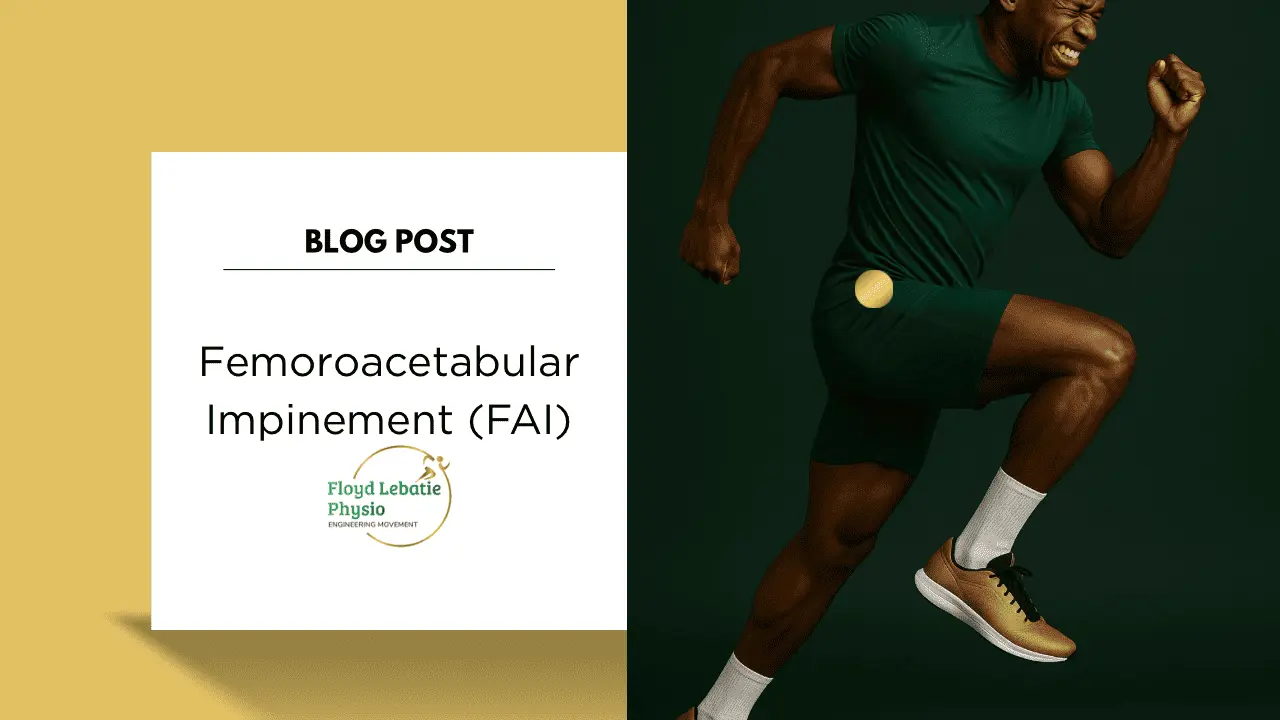Understanding Femoroacetabular Impingement (FAI):
Your guide to causes, diagnosis, treatment, and return-to-sport management.
What is Femoroacetabular Impingement (FAI)?
Femoroacetabular Impingement (FAI) is a common cause of hip and groin pain, particularly in active young adults. It occurs when there’s abnormal contact between the femoral head and the acetabulum, leading to labral tears, cartilage damage, and soft tissue injury, which may predispose patients to early osteoarthritis.
Who is at risk of developing FAI?
FAI is most commonly seen in:
- Young, active adults aged 18–50 years.
- Athletes in sports requiring repetitive hip flexion and rotation, e.g.: Soccer; Hockey; Basketball; Football.
- Those with a family history of hip morphology changes (changes in their bone structure at the hip).
- Evidence: Cam morphology (extra bone growth on the femoral neck) is 2–8x more common in athletes compared to non-athletes, especially males.
What causes FAI?
FAI results from abnormal bone shapes around the hip joint that reduce clearance during movement, leading to impingement. There are three types:
- Cam morphology.
- Pincer.
- Mixed morphology.
- Most common type – involves both cam and pincer features.
What are the symptoms of FAI?
- Groin or hip pain during activity or prolonged sitting.
- Mechanical symptoms: clicking, catching, locking, or popping.
- Reduced hip mobility.
- Pain may refer to the buttock, thigh, or knee.
How is FAI diagnosed?
Diagnosis combines you telling us about your history with this pain, physical assessment from your physiotherapist and x-rays.
- 50–55° = diagnostic for cam deformit
How is FAI managed?
A. Non-Surgical (First-Line) Management
Physiotherapy-led care is supported by strong evidence:
- Pain Management
- NSAIDs.
- Activity modification.
- Exercise-Based Rehabilitation
- Core strengthening: shown to significantly improve outcomes.
- Groin, glute, and trunk strengthening.
- Balance and proprioception (position sense) training (e.g. single-leg stance drills).
- Range of motion restoration.
- Education
- Setting realistic and specific expectations and managing flare-ups.
- Ensuring That Your Strength Metrics Are Optimised
- Meaning that your quads produce a force (Newtons) that is 6x your body weight, your hamstrings produce a force that is 4x your body weight, and your glute and groin produce a force that equal to 3.4x body weight in newtons.
- Graded Walk/Run Program
B. Surgical Intervention
When conservative management fails, hip arthroscopy is the gold-standard surgical option to:
- Removes cam or pincer lesions.
- Repairs or preserves the labrum.
It must also be emphasised that we work very closely with surgeons to make the best decision for our patients regarding the need for surgery.
How long does recovery take?
- Acute Phase
- 0–6 weeks.
- Pain reduction, restore gentle ROM, basic core activation.
- Strength Phase
- 6–12 weeks.
- Progressive strengthening, balance training, endurance work.
- Return-to-Sport Prep
- 3–6 months.
- Sport-specific drills, plyometric progression, graded loading.
- Full Return
- 6–12 months.
- Return to unrestricted training & competition.
Can I return to sport after FAI treatment?
Yes – most athletes successfully return to their pre-injury level of sport.
However, we have certain criteria that needs to be met before return to sport.
Our criteria for muscle strength is as follows:
- Your quads must produce a force (Newtons) that is 6x your body weight, your hamstrings produce a force that is 4x your body weight, and your glute and groin produce a force that equal to 3.4x body weight in newtons.
- You must be able to perform 50 single leg calf raises.
Other criteria includes:
- Having the ability to change direction without pain.
- Perform agility tasks without pain or symptoms.
- You must have adequate cardiovascular and muscular endurance.
Interesting fact: Return-to-sport rates:
- Non-surgical rehab: ~60–70%.
- Post-arthroscopy: 80–90%.
We have a graded return to running program that looks something like this:
We progress your running environment as follows:
- Treadmill
- Track
- Flat road/field running/walking
- Hill running/walking
We progress your walk/run program according to the following criteria, which we measure using our handheld dynamometer, our OptoGait and Kinetisense Technology.
- Progression depends on the return of balance, agility, and the ability to run or fast walk 2km at each level without pain or swelling.
- Muscle Strength.
- Full progression can take up to 3 months.
We follow a protocol that gives a guide/indication on when and how to progress to avoid re-injury and to optimise performance on the road to recovery.
Rest Periods:
- Mandatory 2-day rest between workouts for the first two weeks.
- Two days rest mandatory between levels 1, 2, and 3 workouts.
- One day rest mandatory between levels 4-8 workouts.
Advancement:
We do not advance more than 2 levels per week.
Key Takeaways:
- Diagnosis requires a combination of clinical tests and imaging.
- Individualised rehab focusing on core, adductor, and glute strength is essential.
- Surgery is considered only if conservative treatment fails.
- With proper management, most athletes return to sport within 6–12 months.
References:
- Kemp JL et al., 2019.
- Fortier LM et al., 2022.
- Gatz M et al., 2020.
- Anzillotti V et al., 2022.


